Characteristics of the Main Controlling Factors and Formation–Evolution Process of Karst Collapse Columns in the Hancheng Mining Area, Northern China
Abstract
1. Introduction
2. Regional Geological Background
3. Material Basis of Karst Development in the Hancheng Mining Area and Its Characteristics
3.1. Soluble Formation Solubility Analysis
3.2. Petrological and Sedimentary Characteristics of Soluble Rocks (M5)
3.2.1. Petrological Characteristics
3.2.2. Pore Characteristics
3.2.3. Types and Characteristics of Sedimentary Microfacies
3.2.4. Sedimentary Environment Analysis
4. Structural Geological Conditions and Characteristics of KCC Development
4.1. Tectonic Development Characteristics
4.1.1. Fault
4.1.2. Fold
4.1.3. Joints
4.2. Structural Evolution and Its Regional Lifting Characteristics
4.2.1. The Overall Uplift Denudation Stage of the Caledonian Period
4.2.2. The Development Stage of Fold and Fault Structure Under Continuous Subsidence and North–South Compression System in Indosinian Period
4.2.3. The Thrust Deformation and Rapid Rise and Fall Stage Under the Action of the SE-NW Extrusion System in the Yanshanian Period
4.2.4. The Stage of Fault Development and Differential Uplift Under the Extensional Regime During the Himalayan Period
5. Ancient Hydrogeological Conditions and Karst Development Characteristics in Hancheng Mining Area
5.1. Ancient Hydrogeological Conditions
5.2. Karst Development Time and Its Type
5.2.1. Syngenetic Karst Development Periods
5.2.2. Weathering Crust Karst Development Periods
5.2.3. Buried Karst Development Periods
- (1)
- Middle Carboniferous–Early Cretaceous: Karst Weakening and Development Stage
- (2)
- Late Early Cretaceous: Karst Rapid Development and Reconstruction Stage
6. Discussion on the Development Process and Mechanism of KCCs
6.1. Ordovician Soluble Rock and Syngenetic Period and Weathering Crust Karst Formation Stage
6.1.1. Ordovician Carbonate Deposition and Syngenetic Karst Development Stage
6.1.2. Formation Stage of Weathering Crust Paleokarst
6.2. The Stage of Karst Weakening or Basically Stopping Development in the Indosinian Period (T3-J1)
6.3. Transformation Stage of Karst Development Pattern in Late Yanshanian Period (J3-K1)
6.4. Late Cretaceous–Eocene Karst Vertical Development Formation Stage
6.5. Formation Stage of Neogene Collapse Column
7. Conclusions
- (1)
- The development of KCCs in the study area is based on soluble rocks, among which the fifth member of the Majiagou Formation (M5) serves as the favorable horizon. This horizon exhibits not only low argillaceous content, stable thickness, and well-developed vertical fractures but also domination by thick-bedded massive dolomite in lithology with relatively well-developed secondary pores. Meanwhile, the nearshore tidal flat sedimentary setting—characterized by a dry-hot climate, oxidative environment, relatively high water temperature, and shallow water depth—laid the foundation for early karstification. Furthermore, the spatial distribution and development intensity of tidal flat karst microfacies further controlled the formation locations of KCCs.
- (2)
- Since the Caledonian period, multiple phases of tectonic activities in the study area have generated structures such as faults, folds, joints, and their combinations, coupled with multi-stage crustal uplift and subsidence movements. These tectonic elements together provide favorable tectono-geological conditions for karst development. In particular, the extensional structures formed during the Cenozoic era act as the dominant factor triggering karst collapse. Meanwhile, the development of NE-SW-trending erosional grooves has, to a certain extent, controlled the formation locations of KCCs.
- (3)
- The development process of karst collapse columns (KCCs) in the Hancheng Mining Area can be divided into five stages: During the Ordovician Period, soluble rocks were first formed, accompanied by the development of karst in their weathering crusts. The Indosinian period saw stagnation in karst development. The Late Yanshanian period witnessed the reconstruction of the karst development pattern. From the Late Cretaceous to the Eocene, karst developed vertically and gradually took shape. Finally, KCCs were fully formed in the Neogene period.
- (4)
- Understanding of the key geological controlling factors and multi-stage evolution of karst collapse columns (KCCs) provides theoretical guidance for the prediction and prevention of sudden water hazards induced by KCCs in the Hancheng Mining Area. To a certain extent, it also offers new insights and evidence for exploring the development mechanism of KCCs in North China-type coalfields. In practical mining operations, monitoring areas with paleogeomorphic valleys, syncline hinge zones, and developed extensional faults should be prioritized. Notably, the number of actually exposed KCCs in this study is relatively limited. It is, therefore, recommended that, as exploration and mining activities advance, our current understanding be refined further based on additional field data. This refinement holds direct and significant practical guiding value for ensuring the safe, green, and efficient extraction of coal resources in the Hancheng Mining Area.
Author Contributions
Funding
Data Availability Statement
Acknowledgments
Conflicts of Interest
References
- Yin, S.X.; Lian, H.Q.; Liu, D.M.; Yin, H.C. 70 years of investigation on Karst collapse column in North China Coalfield: Cause of origin, mechanism and prevention. Coal Sci. Technol. 2019, 47, 1–29. [Google Scholar]
- Cao, Z.; Zhang, S.; Li, Z.; Du, F.; Huang, C.; Wang, W. Numerical research on disastrous mechanism of seepage instability of karst collapse column considering variable mass effect. Sci. Rep. 2024, 14, 13900. [Google Scholar] [CrossRef]
- Qian, Z.W.; Lu, C.J.; Gong, Q.L.; Wu, X.S.; Wang, B.Z. Mechanism and application of high pressure grouting in karst collapse column with vein-like water channel. Coal Sci. Technol. 2024, 53, 292–303. [Google Scholar]
- Zhao, J.G.; Wang, J.W.; Yang, G.F.; Guo, M.T. Pillar wall angles of karst collapse pillars in the Xishan coalfield: Characteristics and implications. Coal Geol. Explor. 2024, 52, 23–30. [Google Scholar]
- Zhao, J.G.; Guo, M.T. Discover and formation time of karst collapse pillar in Laomaling, Pingshun County. J. China Coal Soc. 2014, 39, 1716–1724. [Google Scholar]
- Yang, G.F.; Dou, W.W.; Li, W.L. Study on Development Degree of Collapse Column in Changping Mine and Major Controlling Factors for Its Formation. Saf. Coal Mines 2017, 48, 43–46. [Google Scholar]
- Chang, Y.Q. Development Characteristics and Main Control Factors of Karst Collapse Column in Kailuan Fangezhuang Mine Field. Coal Eng. 2019, 51, 76–79. [Google Scholar]
- Zhang, H.T.; Xu, G.Q.; Zhan, H.B.; Zheng, J.B.; Wang, M.H.; Liu, M.C.; Pan, S.Q.; Wang, N. Formation mechanisms of paleokarst and karst collapse columns of the Middle Cambrian-Lower Ordovician carbonates in Huainan coalfield, Northern China. J. Hydrol. 2021, 601, 126634. [Google Scholar] [CrossRef]
- Yin, S.X.; Wu, Q.; Wang, S.X. Water-Bearing Characteristics and Hydro-geological Models of Karstic Collapse Columns in North China. Chin. J. Rock. Mech. Eng. 2005, 24, 77–82. [Google Scholar]
- Yin, S.X.; Xu, B.; Liu, D.M.; Xu, H. Study on location prediction of paleo-karst sinkholes in Northern China Coalfields. Coal Sci. Technol. 2016, 44, 172–177. [Google Scholar]
- Zhao, J.G.; Guo, M.T. The interlayer structures and the karst collapse pillars style of the coal measure strata in Dayaotou village, Eastern Mountain, Taiyuan. J. China Coal Soc. 2013, 38, 1999–2006. [Google Scholar]
- Niu, L.; Wu, Q.; Li, B. Classification of Karst Collapse Columns in North China coalfields based on the generalized model of inside structure of the columns. Coal Geol. Explor. 2015, 43, 56–60. [Google Scholar]
- Gui, H.; Xu, J.P.; Zhang, D. Relationship between hydraulic conductivity of karst collapse column and its surrounding lithology. Environ. Earth Sci. 2017, 76, 215. [Google Scholar] [CrossRef]
- Gui, H.; Yang, Z.B.; Han, X.X. Study on reason for differences of hydraulic conductivity of karst collapse columns in Wanbei Mining Area. Coal Sci. Technol. 2017, 45, 165–169. [Google Scholar]
- Wei, Y.Y.; Sun, S.L. Comprehensive critical mechanical model of covered karst collapse under the effects of positive and negative pressure. Bull. Eng. Geol. Environ. 2018, 77, 177–190. [Google Scholar]
- Xu, G.Q.; Zhang, H.T.; Zhou, J.S.; Li, X.; Wang, M.H.; Liu, M.C. Study and prospect of karst collapse columns and their water inrush in the coalfield of North China. Carsol. Sin. 2022, 41, 259–275. [Google Scholar]
- Liu, X.; Han, W.; Zhang, Q.; Li, Y.G.; Johnson, L.; Ma, Y.; Li, W.H. Sedimentary and geochronological studies on tuff levels from Triassic strata in the Nanzhao Basin, North Qinling Orogenic Belt, and their geological significance. Geol. J. 2021, 56, 1531–1548. [Google Scholar] [CrossRef]
- Li, W.H.; Chen, Q.; Li, Z.C.; Wang, R.G.; Wang, Y.; Ma, Y. Lithofacies palaeogeography of the Early Paleozoic in Ordos area. J. Palaeogeogr. 2012, 14, 85–100. [Google Scholar]
- Ren, J.F.; Shi, P.P.; Zhang, T.; Wei, L.B.; Bao, H.P.; Wang, Q.P. Characteristics and exploration potential of Ordovician subsalt gas-bearing system in the Ordos Basin. Nat. Gas Geosci. 2024, 35, 435–448. [Google Scholar]
- Wu, D.X.; Zhou, J.G.; Ren, J.F.; Li, W.L.; Wei, L.B.; Yu, Z.; Zhang, C.L.; Wang, S.Y. Reconstruction of Depositional Environment and Source⁃Reservoir Configuration Relationship of Ordovician Majiagou Formation in Ordos Basin. Earth Sci. 2023, 48, 553–567. [Google Scholar]
- Yu, Z.; Hu, Z.J.; Wang, Q.P.; Zhao, J.; Wu, D.X.; Wu, X.N.; Li, H.L.; Zhu, W.B. Characteristics and main controlling factors of the Ordovician deep dolomite reservoirs in mid-eastern Ordos Basin. J. Palaeogeogr. 2023, 25, 931–944. [Google Scholar]
- Yang, S.R.; Gang, W.Z.; Cao, J.J.; Liu, J.P.; Gao, G.; Dang, W.L. Geochemical characteristics, origin and carbon isotope reversal of the presalt natural gas in the Lower Paleozoic Ordovician carbonates, Ordos Basin, China. Mar. Pet. Geol. 2022, 139, 105577. [Google Scholar] [CrossRef]
- Hou, L.J.; Su, Z.T.; Wei, L.B.; Wei, X.S.; Zhang, C.G.; Fu, S.Y.; Han, Y.; Ren, J.F.; Chen, H.D. Residual carbonate karst reservoir reconstructed by karst planation: A case study of Ordovician paleokarst reservoir characterization in Ordos Basin, North China. Geoenergy Sci. Eng. 2024, 233, 212508. [Google Scholar] [CrossRef]
- Li, W.H.; Zhang, Q.; Li, K.Y.; Chen, Q.; Guo, Y.Q.; Ma, Y.; Feng, J.P.; Zhang, D.F. Sedimentary evolution of the late Paleozoic in Ordos Basin and its adjacent areas. J. Palaeogeogr. 2021, 23, 39–52. [Google Scholar]
- Xu, L.M.; Zhou, L.F.; Zhang, Y.K.; Dang, B. Characteristics and Tectonic setting of Tectono-Stress field of Ordos Basin. Geotecton. Metallog. 2006, 30, 455–462. [Google Scholar]
- Wu, J.W.; Tang, W.; Zhu, Y.H.; Wang, C.W.; Tian, Y.J.; Zi, J.Y.; Yang, J.H.; Shi, X. Evaluation method and application for in-situ stress in No. 8+9 coal seam. southern Shenfu block, northeastern margin of Ordos Basin. Pet. Geol. Exp. 2025, 47, 27–42. [Google Scholar]
- Wang, S.M. Geological Conditions and Occurrence Law of Coalbed Methane in Hancheng Mining Area; Geological Publishing House: Beijing, China, 2008; ISBN 978-71-1605-987-0. [Google Scholar]
- Sun, T.C. Kinematics and Dynamics Analysis of Geological Structures in Hancheng Mining Area. Master’s Thesis, Xi’an University of Science and Technology, Xi’an, China, 2017. [Google Scholar]
- Huang, Z.G.; Ren, Z.L.; Chen, Y.L. Thermal Evolution History of Yanchang Formation in the Southeastern Margin of theOrdos Basin: Evidence from Vitrinite-Reflectance and Apatite Fission-Track. Acta Geol. Sin. 2015, 89, 909–916. [Google Scholar]
- Huang, Z.G.; Ren, Z.L.; Gao, L.G. Evidence from detrital zircon and apatite fission track for tectonic evolution since Cretaceous in southeastern margin of Ordos Basin. Chin. J. Geophys. 2016, 59, 3753–3764. [Google Scholar]
- He, F.Q.; Huang, L.; Jia, H.C.; Zhang, R.; Zhang, W.; Wang, Z.; Li, X.W. Characteristics of strike-slip faults and their oil-gas-controlling effect in the Ordos basin. Acta Geol. Sin. 2025, 99, 520–534. [Google Scholar]
- Wu, H.N.; Zhou, L.F.; Zhao, C.Y. Paleomagnetic Study on the Carboniferous-Permian System in the Alxa Area and Its Adjacent Regions and Its Significance. Sci. Sin. Chim. 1993, 23, 527–536. [Google Scholar]
- Lei, Q.Y.; Zhang, P.Z.; Zheng, W.J.; Chai, C.Z.; Wang, W.T.; Du, P.; Yu, J.X. Dextral strike-slip of Sanguankou-Niushoushan fault zone and extension of arc tectonic belt in the northeastern margin of the Tibet Plateau. Sci. Sin. 2016, 59, 1025–1040. [Google Scholar] [CrossRef]
- Chang, L.J.; Ding, Z.F.; Wang, C.Y. Upper mantle anisotropy and implications beneath the central and western North China and the NE margin of Tibetan Plateau. Chin. J. Geophys. 2021, 64, 114–130. [Google Scholar]
- Yao, J.L.; Wang, L.P.; Zhang, Q.; Li, Z.M.; Zhang, J.L. Controlling Factor and Distribution of Paleo-karst Development in Ordovician of Southern Ordos Basin. Nat. Gas Geosci. 2011, 22, 56–65. [Google Scholar]
- Wei, X.S.; Chen, H.D.; Zhang, D.F.; Dai, R.; Guo, Y.R.; Chen, J.P.; Ren, J.F.; Liu, N.; Luo, S.S.; Zhao, J.X. Gas exploration potential of tight carbonate reservoirs: A case study of Ordovician Majiagou Formation in the eastern Yi-Shan slope, Ordos Basin, NW China. Pet. Explor. Dev. 2017, 44, 319–329. [Google Scholar] [CrossRef]
- Wang, G.; Zhong, X.Y.; Zhang, C.G.; Fang, J.Y.; Li, J.J. Sedimentary miscrofacies and their distribution law of Majiagou Formation in southeastern Ordos Basin, China. J. Chengdu Univ. Technol. Sci. Technol. Ed. 2019, 46, 326–333. [Google Scholar]
- Gromet, L.P.; Haskin, L.A.; Korotev, R.L.; Dymek, R.F. The “North American shale composite”: Its compilation, major and trace element characteristics. Geochim. Cosmochim. Acta 1984, 48, 2469–2482. [Google Scholar] [CrossRef]
- Veizer, J.; Demovic, R. Strontium as a tool in facies analysis. J. Sediment. Res. 1974, 44, 93–115. [Google Scholar] [CrossRef]
- Liu, Z.J.; Meng, Q.T.; Liu, R.; Dong, Q.S. Geochemical characteristics of oil shale of Eocene Jijuntun Formation and its geological significance, Fushun Basin. Acta Petrol. Sin. 2009, 25, 2340–2350. [Google Scholar]
- He, Y.Y.; Zhao, G.T.; Zhao, L.; Long, X.J.; Qi, Q.; Xu, C.L. Geochemistry characteristics and Palaeo-Environment Significance of Qixia Formation in Chaobei Area. Period. Ocean Univ. China 2014, 44, 79–88. [Google Scholar]
- Lerman, A. Lakes: Chemistry, Geology, Physics; Wang, S., Translator; Geological Publishing House: Beijing, China, 1989; ISBN 978-71-1600-469-6. [Google Scholar]
- Hou, E.G.; Gao, J.H.; Wang, X.L.; Wang, G.H.; Rui, H.X.; Ma, Z.C. Geochemical Characteristics and Environmental Significance of the Upper Triassic Riganpeicuo Formation in Gaize, Tibet. Bull. Miner. Petrol. Geochem. 2015, 34, 556–563. [Google Scholar]
- Braun, J.J.; Pagel, M.; Herbilln, A.; Rosin, C. Mobilization and redistribution of REEs and thorium in a syenitic lateritic profile: A mass balance study. Geochim. Cosmochim. Acta 1993, 57, 4419–4434. [Google Scholar] [CrossRef]
- Huang, C.M.; Gong, Z.T. Geochemical Implication of Rare Earth Elements in Process of Soil Development. J. Chin. Soc. Rare Earths. 2000, 150–155. [Google Scholar] [CrossRef]
- Hallberg, J.A.; Johnston, C.; Bye, S.M. The Archaean Marda igneous complex, Western Australia. Precambrian Res. 1976, 3, 111–136. [Google Scholar] [CrossRef]
- Xia, Y.C.; Sun, T.C.; Liang, Q.W.; Wang, S.R.; Du, S.H.; Liu, P.C. Geometry and geodynamic mechanism of buckle folds in Hancheng mining area. J. China Coal Soc. 2018, 43, 801–809. [Google Scholar]
- Wang, S.Q.; Li, S.G.; Wang, G.R.; Qian, J.F.; Wei, Z.X. Control factors of coal and gas outburst and regional prediction in Hancheng mining area, Shaanxi. Coal Geol. Explor. 2006, 34, 36–39. [Google Scholar]
- Sun, X.Y.; Zhang, Q.; Xia, Y.C.; Du, R.J.; Guo, C. Principle and methods of identifying favorable mining blocks of coal resources in Hancheng Mining Area. Coal Sci. Technol. 2020, 48, 232–240. [Google Scholar]
- Wang, H.; Fan, Y.H.; Sheng, C.; He, X.D.; Jin, M.S.; Pan, C.J.; Min, L.; Peng, Z.S. Analysis of tectonic deformation features and tectonic origin in the south of Hancheng mining area. Coal Geol. Explor. 2017, 45, 1–7+13. [Google Scholar]
- Liang, Q.W. Geometric Analysis of the Geological Structures in Hancheng Mining Area. Master’s Thesis, Xi’an University of Science and Technology, Xi’an, China, 2017. [Google Scholar]
- Ren, Z.L.; Cui, J.P.; Bu, L.J.; Wang, J.P.; Guo, K.; Wang, W.; Tian, T.; Hao, L.; Cao, Z.P.; Yang, P. Tectonic-Thermal History Reconstruction of Ordovician in the Weibei Uplift of Ordos Basin. Acta Geol. Sin. 2014, 88, 2044–2056. [Google Scholar]
- Ren, Z.L.; Cui, J.P.; Guo, K.; Tian, T.; Li, H.; Wang, W.; Yang, P.; Cao, Z.P. Fission-track analysis of uplift times and processes of the Weibei Uplift in the Ordos Basin. Chin. Sci. Bull. 2015, 60, 1298–1309. [Google Scholar] [CrossRef]
- Zuo, L.Q. Review on methods of paleo-geomorphologic restoration. Pet. Geol. Eng. 2019, 33, 12–16+21. [Google Scholar]
- Zheng, S. Evaluation of Impermeability in the Top of Ordovician Limestone in North China Type Coal Field. Master’s Thesis, Xi’an University of Science and Technology, Xi’an, China, 2015. [Google Scholar]
- Qu, H.Z.; Guo, X.Y.; Xu, W.; Li, W.H.; Deng, Y.N.; He, S.P.; Zhang, Y.F.; Zhang, X.Y. Classification and origin of micropores in carbonates and their effects on physical properties of rocks. Oil Gas Geol. 2023, 44, 1102–1117. [Google Scholar]
- Xiang, J.; Guo, F.; Ma, J.B.; Wu, X.Y.; Zhang, H.M.; Wu, F.F.; Fang, Z.X.; Pan, Q.; Guo, L. Diagenetic, evolutionary characteristics and hydrocarbon generation potential evaluation of tight sandstone reservoirs in Ansai oilfield: A case from the Chang 6 of Yanchang Formation at the Huaziping area. Geol. Bull. China 2025, 44, 1215–1231. [Google Scholar]
- She, M.; Jiang, Y.M.; HU, A.P.; Lu, Y.Z.; Chen, W.; Wang, Y.S.; Wang, Y. The progress and application of dissolution simulation of carbonate rock. Mar. Orig. Pet. Geol. 2020, 25, 12–21. [Google Scholar]
- Yuan, W.; Yang, Z.Y. The Alashan Terrane did not amalgamate with North China block by the Late Permian: Evidence from Carboniferous and Permian paleomagnetic results. J. Asian Earth Sci. 2015, 104, 145–159. [Google Scholar] [CrossRef]
- Sun, T.C.; Xia, Y.C.; Wei, Z.X.; Guo, C.; Wang, S.R.; Liang, Q.W.; Qi, Y.W. Uplift-subsidence movement and its control effect on coal in Hancheng Mining area since Late Carboniferous. J. Xi’an Univ. Sci. Technol. 2017, 37, 674–679. [Google Scholar]
- Liu, J.; Zhang, P.; Lease, R.O.; Zheng, D.; Wan, J.; Wang, W.; Zhang, H. Eocene onset and late Miocene acceleration of Cenozoic intracontinental extension in the North Qinling range–Weihe graben: Insights from apatite fission track thermochronology. Tectonophysics 2013, 584, 281–296. [Google Scholar] [CrossRef]
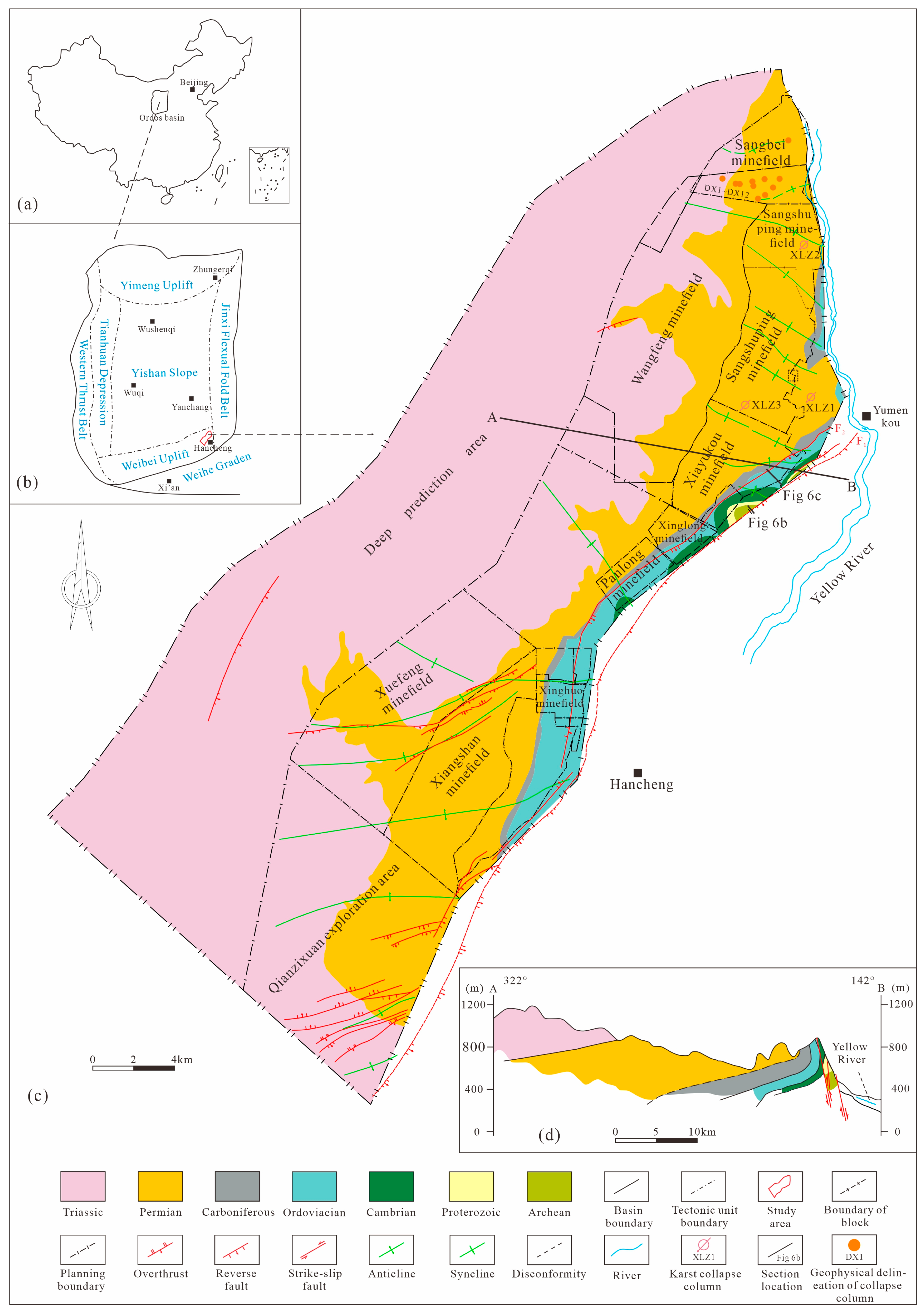
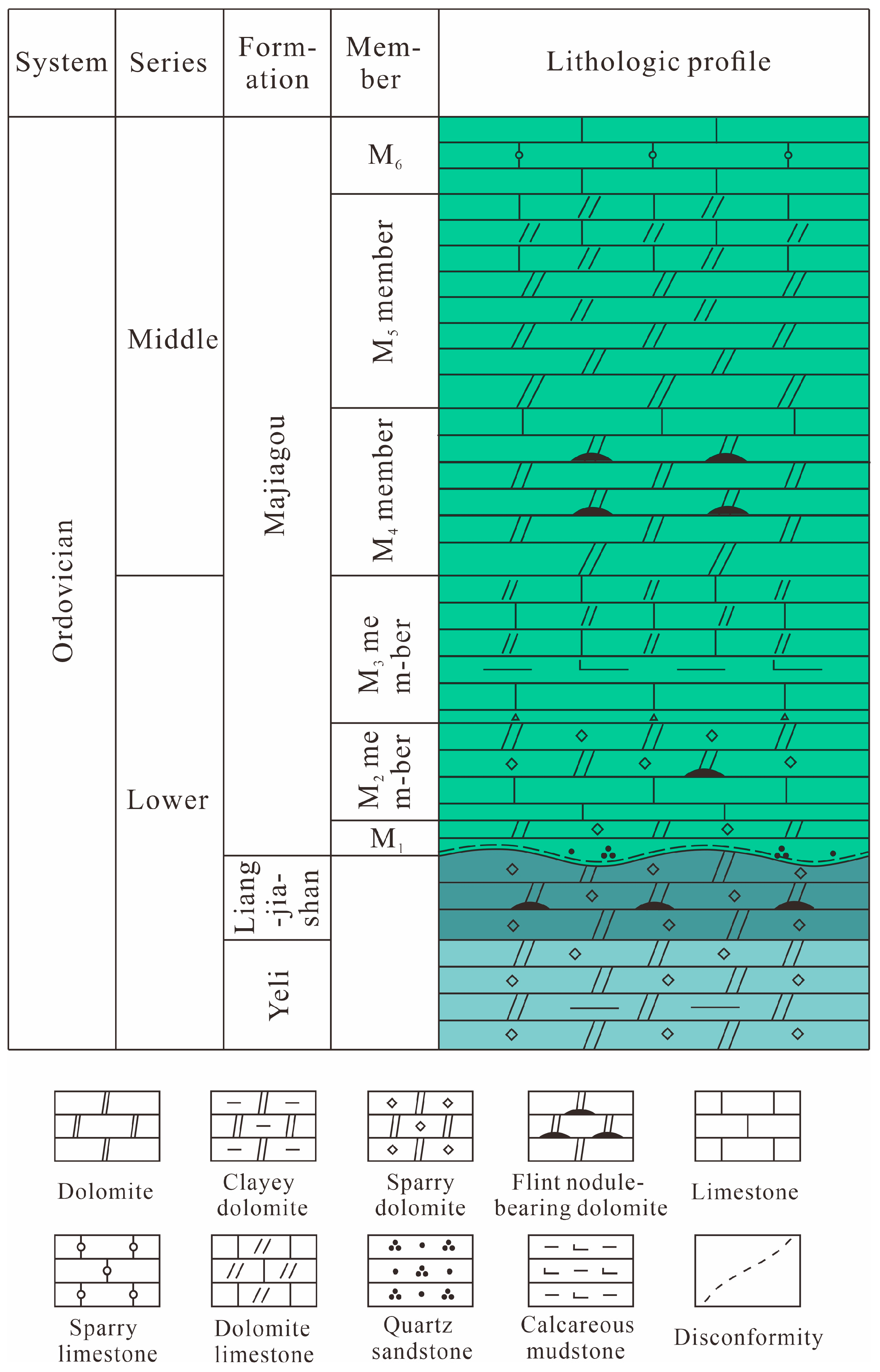
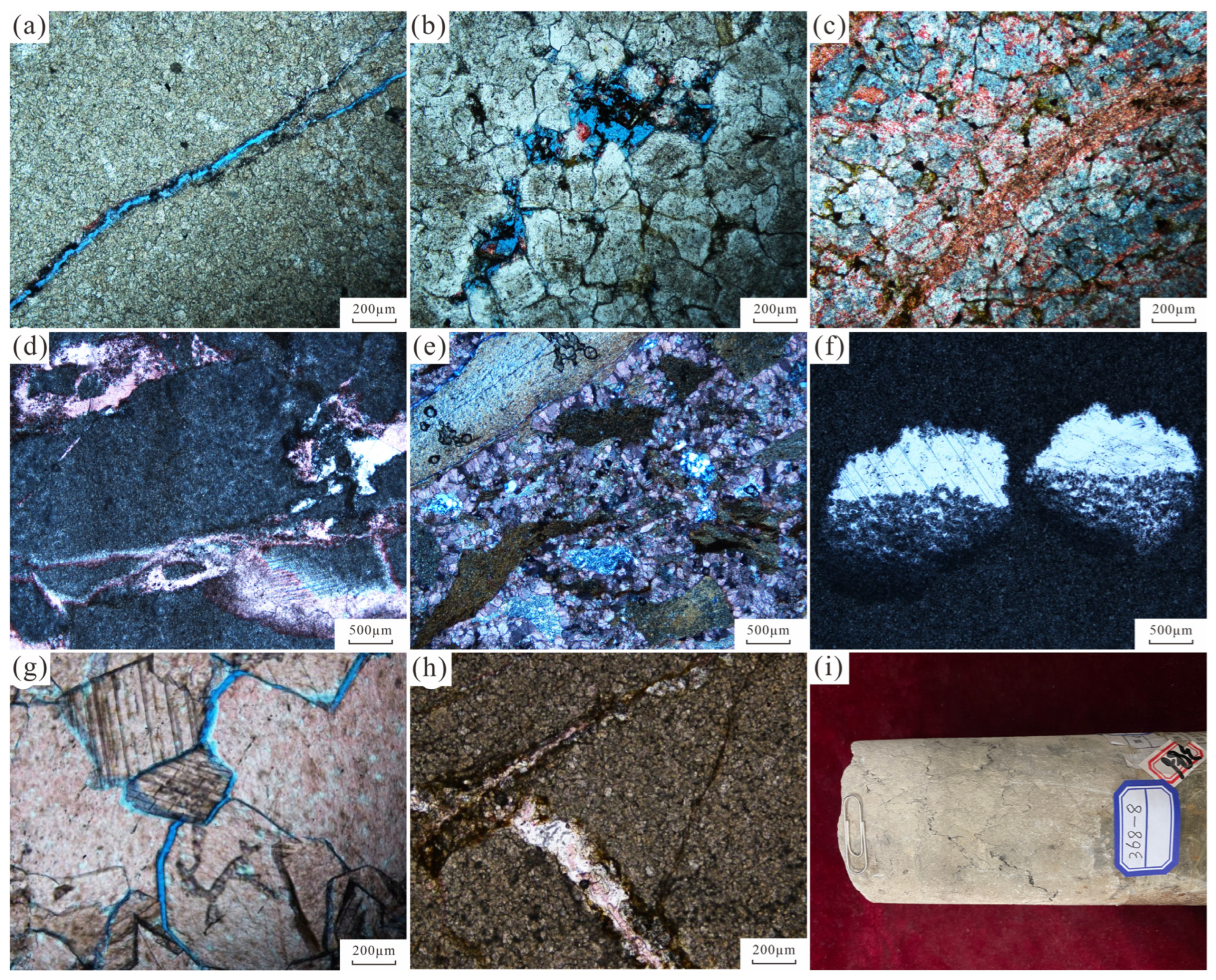
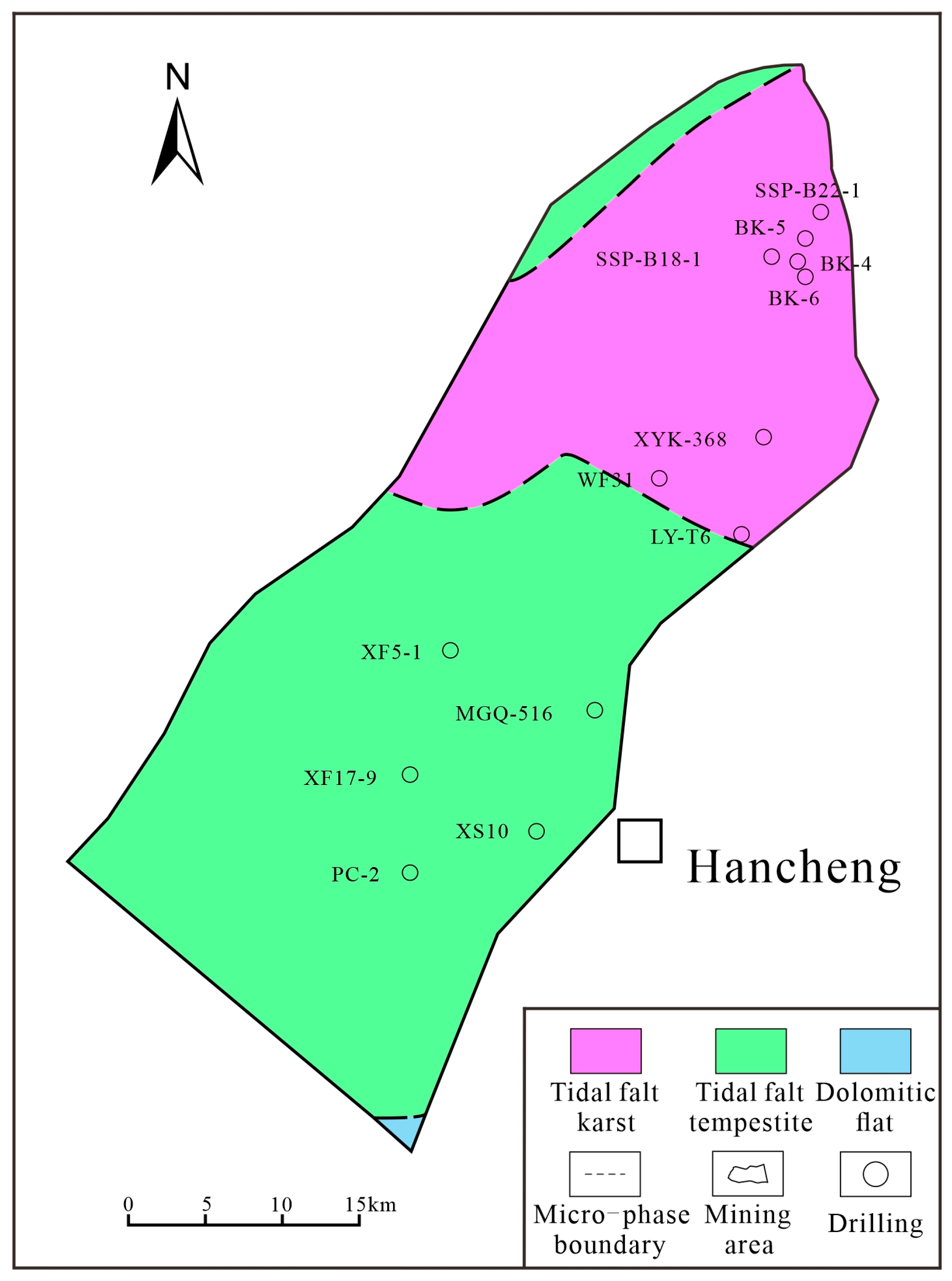
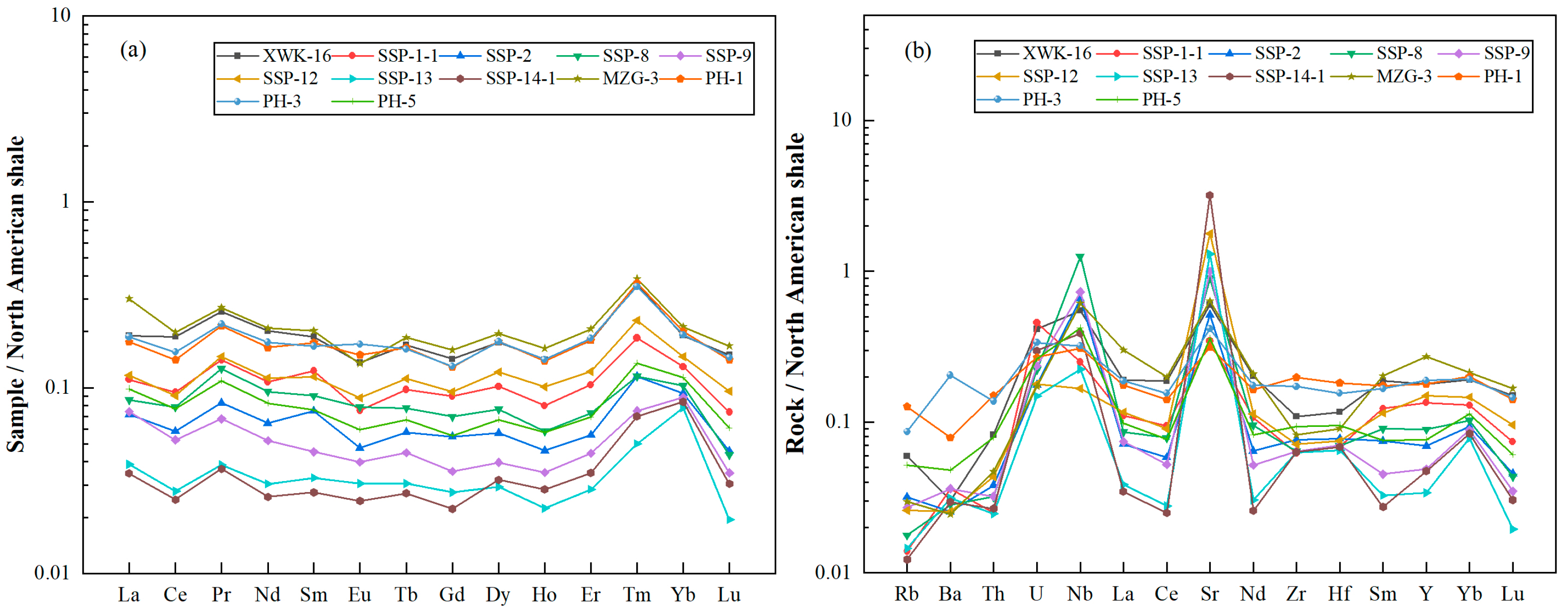

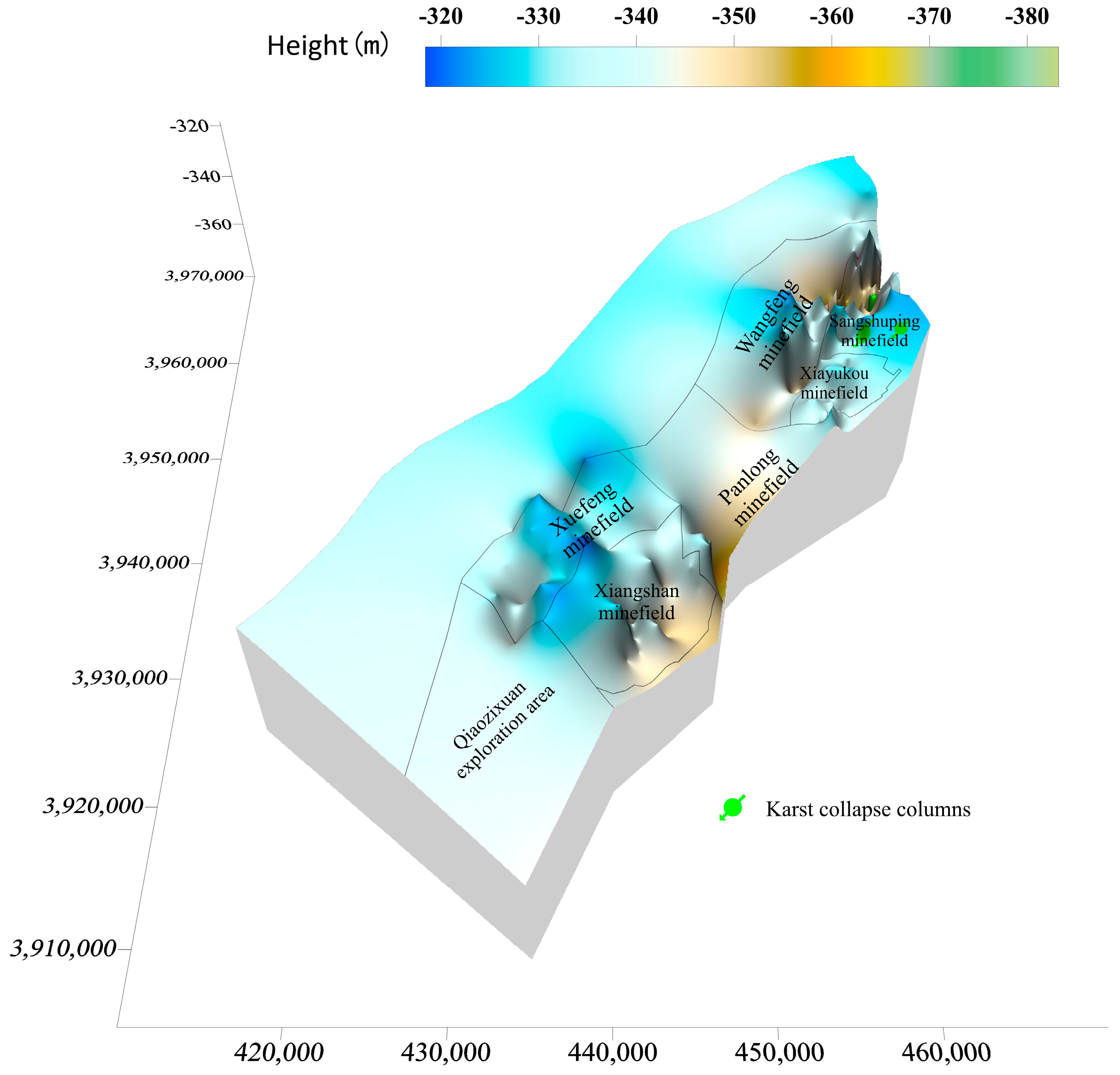
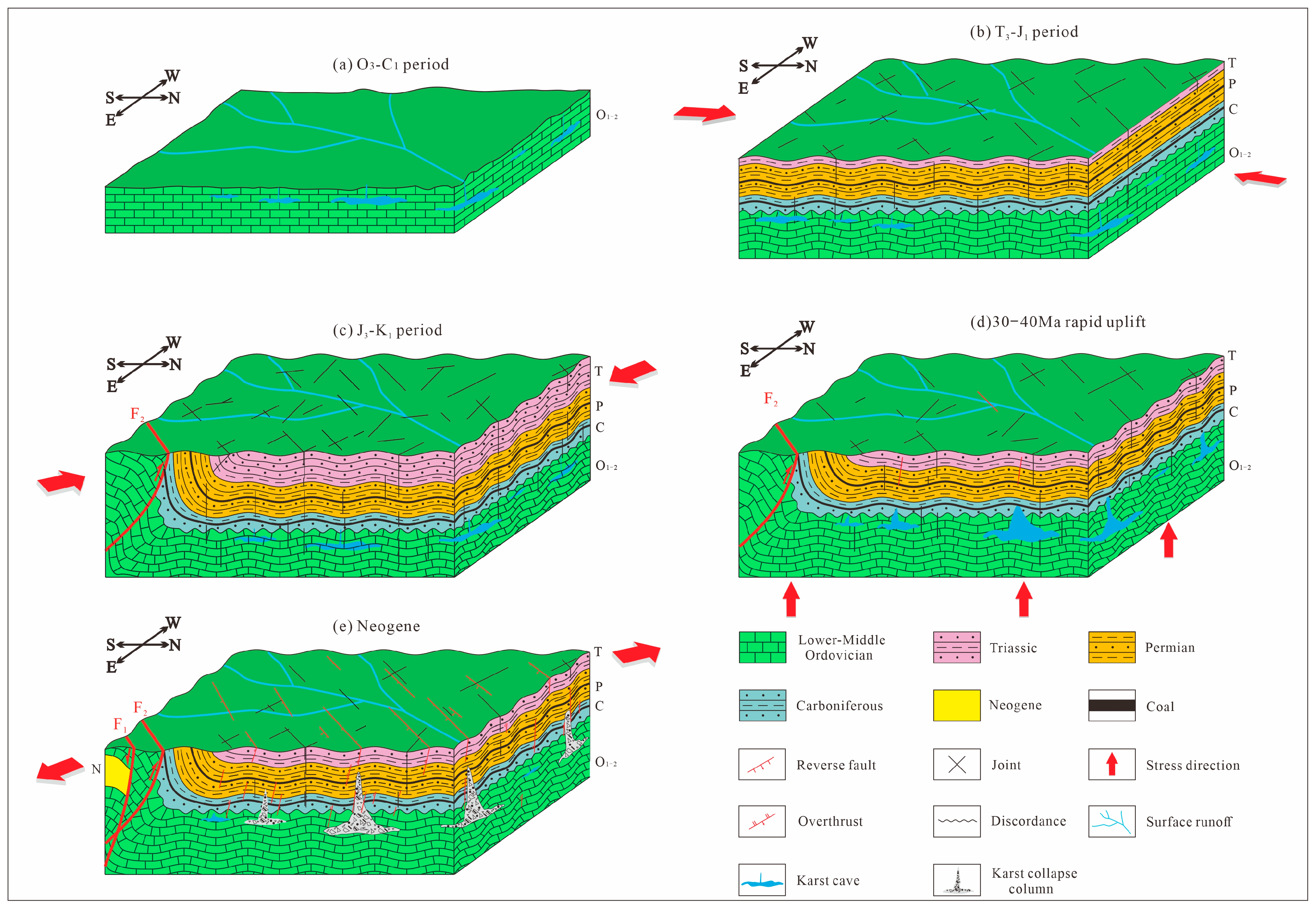
| Sample No. | XWK-16 | SSP-1-1 | SSP-2 | SSP-8 | SSP-9 | SSP-12 | SSP-13 | SSP-14-1 | MZG-3 | PH-1 | PH-3 | PH-5 | Average |
|---|---|---|---|---|---|---|---|---|---|---|---|---|---|
| Be | 0.04 | 0.06 | 0.13 | 0.27 | 0.07 | 0.06 | 0.02 | 0.07 | 0.10 | 0.10 | 0.19 | 0.01 | 0.09 |
| Li | 18.75 | 11.33 | 7.92 | 11.82 | 15.07 | 11.59 | 9.38 | 10.87 | 12.29 | 9.49 | 9.71 | 7.53 | 11.31 |
| Sc | 3.50 | 2.31 | 2.07 | 2.92 | 3.16 | 3.08 | 3.07 | 2.40 | 3.22 | 13.95 | 16.73 | 5.70 | 5.18 |
| V | 1.27 | 0.70 | 0.75 | 0.86 | 0.75 | 1.47 | 0.69 | 0.86 | 1.29 | 2.84 | 2.05 | 1.10 | 1.22 |
| Cr | 23.32 | 14.06 | 16.28 | 17.32 | 20.09 | 16.89 | 16.13 | 16.96 | 15.70 | 22.07 | 19.18 | 17.87 | 17.99 |
| Co | 4.13 | 4.98 | 2.89 | 2.76 | 2.84 | 3.28 | 2.98 | 3.44 | 4.06 | 4.18 | 7.35 | 3.78 | 3.89 |
| Ni | 4.92 | 14.47 | 3.29 | 15.18 | 4.34 | 14.66 | 10.20 | 14.16 | 13.30 | 3.47 | 5.48 | 3.85 | 8.94 |
| Cu | 2.95 | 4.30 | 2.98 | 2.83 | 2.94 | 2.65 | 2.44 | 2.42 | 3.97 | 8.70 | 9.04 | 7.15 | 4.36 |
| Zn | 8.52 | 10.12 | 10.82 | 7.78 | 9.74 | 8.85 | 11.21 | 8.06 | 7.93 | 12.22 | 13.26 | 11.00 | 9.96 |
| Ga | 1.26 | 0.41 | 0.66 | 0.42 | 0.84 | 0.69 | 0.49 | 0.45 | 0.69 | 2.25 | 1.58 | 0.92 | 0.89 |
| Rb | 7.46 | 1.74 | 3.98 | 2.22 | 3.40 | 3.24 | 1.81 | 1.54 | 3.71 | 15.80 | 10.81 | 6.47 | 5.18 |
| Sr | 85.34 | 48.92 | 73.06 | 128.23 | 142.35 | 252.63 | 184.36 | 454.46 | 90.05 | 44.59 | 59.09 | 50.96 | 134.50 |
| Y | 4.66 | 3.50 | 1.81 | 2.32 | 1.27 | 3.89 | 0.88 | 1.23 | 7.06 | 4.65 | 4.91 | 1.99 | 3.18 |
| Zr | 21.77 | 12.46 | 15.20 | 12.80 | 12.82 | 14.21 | 12.57 | 12.67 | 16.45 | 39.60 | 34.44 | 18.63 | 18.63 |
| Nb | 6.03 | 2.75 | 7.27 | 13.80 | 8.04 | 1.84 | 2.46 | 4.27 | 6.75 | 3.40 | 3.53 | 4.63 | 5.40 |
| Mo | 0.58 | 0.18 | 0.18 | 0.17 | 0.27 | 0.18 | 0.17 | 0.23 | 0.16 | 0.26 | 0.49 | 0.29 | 0.26 |
| Cd | 0.04 | 0.07 | 0.03 | 0.04 | 0.04 | 0.08 | 0.05 | 0.03 | 0.15 | 0.03 | 0.06 | 0.04 | 0.05 |
| In | 0.03 | 0.05 | 0.03 | 0.03 | 0.03 | 0.03 | 0.03 | 0.02 | 0.03 | 0.04 | 0.03 | 0.03 | 0.03 |
| Sn | 0.60 | 1.04 | 0.51 | 0.51 | 0.42 | 0.51 | 0.44 | 0.50 | 0.47 | 0.71 | 0.67 | 0.56 | 0.58 |
| Sb | 0.10 | 0.13 | 0.13 | 0.15 | 0.12 | 0.10 | 0.13 | 0.11 | 0.17 | 0.12 | 0.29 | 0.15 | 0.14 |
| Te | 0.04 | 0.04 | 0.05 | 0.08 | 0.04 | 0.03 | 0.03 | 0.05 | 0.07 | 0.02 | 0.01 | 0.03 | 0.04 |
| Cs | 0.42 | 0.29 | 0.38 | 0.24 | 0.28 | 0.33 | 0.29 | 0.27 | 0.39 | 0.61 | 0.52 | 0.32 | 0.36 |
| Ba | 19.20 | 22.94 | 16.20 | 18.01 | 23.05 | 16.27 | 19.89 | 18.82 | 15.63 | 50.10 | 129.91 | 30.62 | 31.72 |
| Hf | 0.74 | 0.43 | 0.49 | 0.44 | 0.44 | 0.47 | 0.41 | 0.43 | 0.57 | 1.15 | 0.98 | 0.60 | 0.60 |
| Ta | 1.19 | 0.95 | 2.30 | 4.67 | 5.75 | 0.65 | 1.34 | 1.09 | 1.55 | 0.42 | 0.63 | 1.32 | 1.82 |
| W | 12.11 | 8.37 | 5.73 | 2.28 | 13.72 | 5.63 | 4.82 | 4.84 | 4.67 | 5.66 | 8.08 | 7.57 | 6.96 |
| Ti | 0.11 | 0.09 | 0.09 | 0.10 | 0.09 | 0.10 | 0.09 | 0.08 | 0.09 | 0.24 | 0.15 | 0.13 | 0.11 |
| Pb | 2.35 | 3.48 | 1.54 | 2.45 | 2.23 | 2.35 | 2.39 | 2.39 | 4.58 | 5.61 | 10.86 | 5.05 | 3.77 |
| Bi | 0.10 | 0.12 | 0.10 | 0.10 | 0.12 | 0.15 | 0.12 | 0.11 | 0.14 | 0.15 | 0.14 | 0.13 | 0.12 |
| Th | 1.01 | 0.31 | 0.47 | 0.39 | 0.40 | 0.53 | 0.30 | 0.33 | 0.58 | 1.84 | 1.69 | 0.97 | 0.74 |
| U | 1.11 | 1.21 | 0.47 | 0.59 | 0.63 | 0.48 | 0.40 | 0.79 | 0.46 | 0.72 | 0.90 | 0.70 | 0.70 |
| Cu/Zn | 0.35 | 0.42 | 0.28 | 0.36 | 0.30 | 0.30 | 20.00 | 0.30 | 0.50 | 0.71 | 0.68 | 0.68 | 0.42 |
| Sr/Ba | 4.45 | 2.13 | 4.51 | 7.12 | 6.18 | 15.53 | 9.27 | 24.14 | 5.76 | 0.89 | 0.45 | 1.66 | 6.84 |
| Sr/Cu | 28.95 | 11.39 | 24.48 | 45.31 | 48.42 | 95.51 | 75.59 | 187.95 | 22.68 | 5.12 | 6.54 | 7.12 | 46.59 |
| La | 5.91 | 3.44 | 2.23 | 2.68 | 2.31 | 3.62 | 1.20 | 1.08 | 9.35 | 5.47 | 5.83 | 3.07 | 3.85 |
| Ce | 12.54 | 6.31 | 3.89 | 5.24 | 3.50 | 6.04 | 1.86 | 1.67 | 13.26 | 9.40 | 10.35 | 5.13 | 6.60 |
| Pr | 1.43 | 0.79 | 0.46 | 0.71 | 0.38 | 0.83 | 0.22 | 0.21 | 1.51 | 1.21 | 1.23 | 0.61 | 0.80 |
| Nd | 5.52 | 2.94 | 1.77 | 2.61 | 1.42 | 3.10 | 0.83 | 0.71 | 5.71 | 4.51 | 4.80 | 2.25 | 3.01 |
| Sm | 1.05 | 0.69 | 0.42 | 0.51 | 0.25 | 0.64 | 0.18 | 0.15 | 1.13 | 0.97 | 0.93 | 0.42 | 0.61 |
| Eu | 0.16 | 0.09 | 0.06 | 0.09 | 0.05 | 0.10 | 0.04 | 0.03 | 0.16 | 0.18 | 0.20 | 0.07 | 0.10 |
| Tb | 0.14 | 0.08 | 0.05 | 0.07 | 0.04 | 0.10 | 0.03 | 0.02 | 0.16 | 0.14 | 0.14 | 0.06 | 0.08 |
| Gd | 0.91 | 0.58 | 0.35 | 0.45 | 0.23 | 0.61 | 0.18 | 0.14 | 1.02 | 0.83 | 0.83 | 0.35 | 0.54 |
| Dy | 0.81 | 0.47 | 0.26 | 0.35 | 0.18 | 0.56 | 0.14 | 0.15 | 0.90 | 0.82 | 0.81 | 0.31 | 0.48 |
| Ho | 0.17 | 0.10 | 0.06 | 0.07 | 0.04 | 0.12 | 0.03 | 0.03 | 0.20 | 0.17 | 0.17 | 0.07 | 0.10 |
| Er | 0.45 | 0.26 | 0.14 | 0.18 | 0.11 | 0.31 | 0.07 | 0.09 | 0.52 | 0.45 | 0.46 | 0.17 | 0.27 |
| Tm | 0.07 | 0.04 | 0.02 | 0.02 | 0.02 | 0.05 | 0.01 | 0.01 | 0.08 | 0.07 | 0.07 | 0.03 | 0.04 |
| Yb | 0.58 | 0.40 | 0.29 | 0.31 | 0.27 | 0.45 | 0.24 | 0.26 | 0.65 | 0.61 | 0.59 | 0.35 | 0.42 |
| Lu | 0.07 | 0.03 | 0.02 | 0.02 | 0.02 | 0.04 | 0.01 | 0.01 | 0.08 | 0.07 | 0.07 | 0.03 | 0.04 |
| Σ REE | 29.81 | 16.20 | 10.01 | 13.31 | 8.81 | 16.55 | 5.02 | 4.56 | 34.72 | 24.89 | 26.49 | 12.92 | 16.94 |
| (La/Yb)N’ | 1.00 | 0.85 | 0.77 | 0.84 | 0.84 | 0.80 | 0.49 | 0.41 | 1.41 | 0.88 | 0.97 | 0.87 | 0.87 |
| δCe | 0.85 | 0.76 | 0.76 | 0.75 | 0.74 | 0.69 | 0.72 | 0.70 | 0.70 | 0.72 | 0.76 | 0.74 | 0.74 |
Disclaimer/Publisher’s Note: The statements, opinions and data contained in all publications are solely those of the individual author(s) and contributor(s) and not of MDPI and/or the editor(s). MDPI and/or the editor(s) disclaim responsibility for any injury to people or property resulting from any ideas, methods, instructions or products referred to in the content. |
© 2025 by the authors. Licensee MDPI, Basel, Switzerland. This article is an open access article distributed under the terms and conditions of the Creative Commons Attribution (CC BY) license (https://creativecommons.org/licenses/by/4.0/).
Share and Cite
Chen, Y.; Yang, X.; Zhang, H.; Dai, G.; Luo, S.; Yu, W. Characteristics of the Main Controlling Factors and Formation–Evolution Process of Karst Collapse Columns in the Hancheng Mining Area, Northern China. Water 2025, 17, 3112. https://doi.org/10.3390/w17213112
Chen Y, Yang X, Zhang H, Dai G, Luo S, Yu W. Characteristics of the Main Controlling Factors and Formation–Evolution Process of Karst Collapse Columns in the Hancheng Mining Area, Northern China. Water. 2025; 17(21):3112. https://doi.org/10.3390/w17213112
Chicago/Turabian StyleChen, Yingtao, Xufeng Yang, Huan Zhang, Gelian Dai, Shoutao Luo, and Wenxin Yu. 2025. "Characteristics of the Main Controlling Factors and Formation–Evolution Process of Karst Collapse Columns in the Hancheng Mining Area, Northern China" Water 17, no. 21: 3112. https://doi.org/10.3390/w17213112
APA StyleChen, Y., Yang, X., Zhang, H., Dai, G., Luo, S., & Yu, W. (2025). Characteristics of the Main Controlling Factors and Formation–Evolution Process of Karst Collapse Columns in the Hancheng Mining Area, Northern China. Water, 17(21), 3112. https://doi.org/10.3390/w17213112






